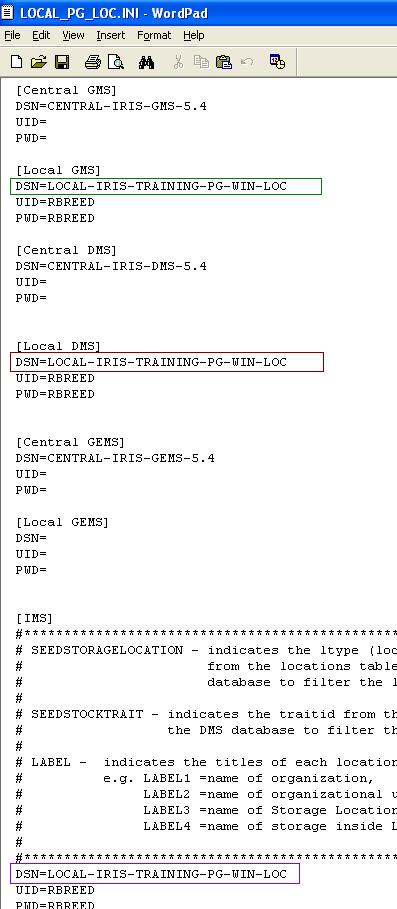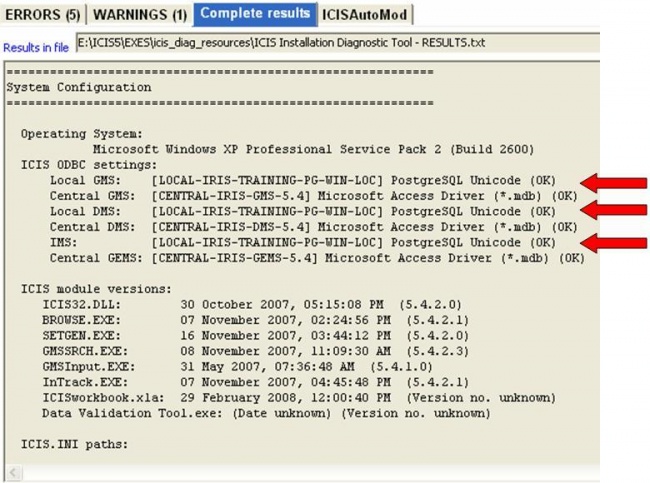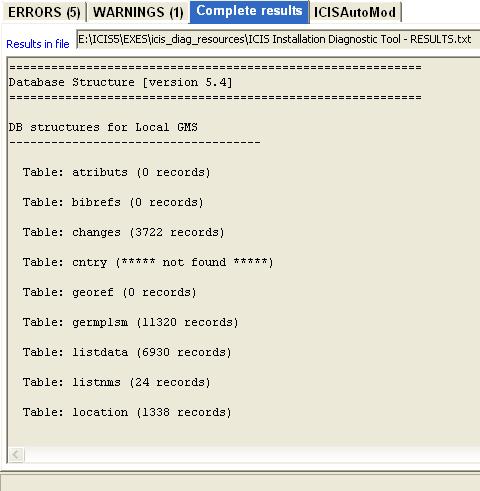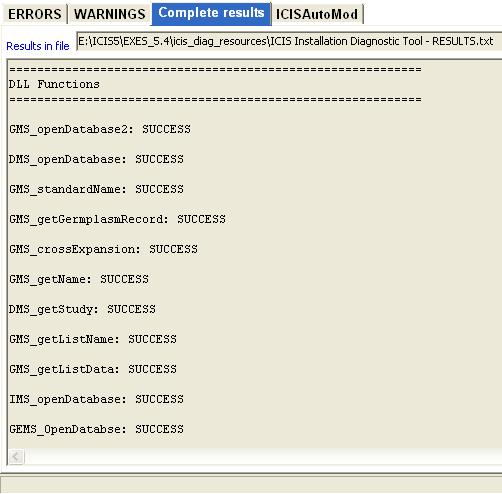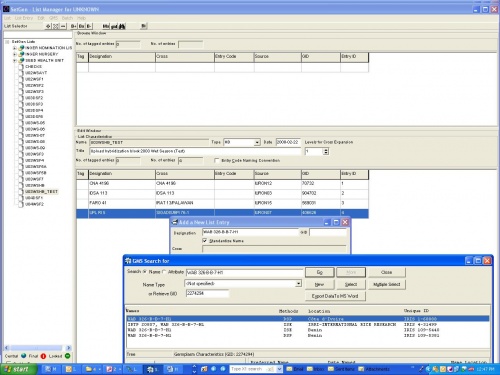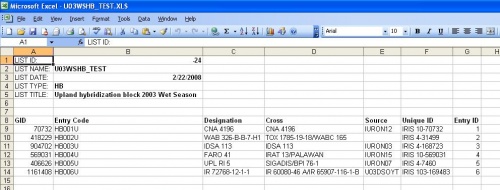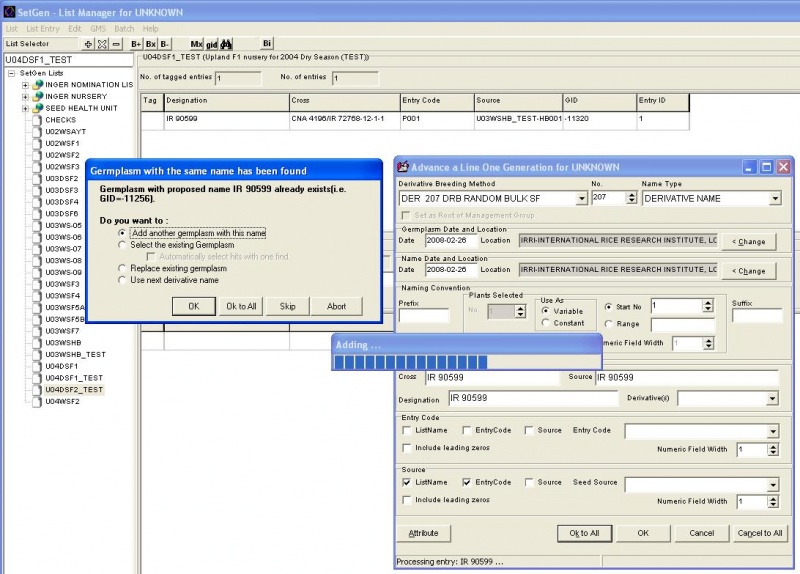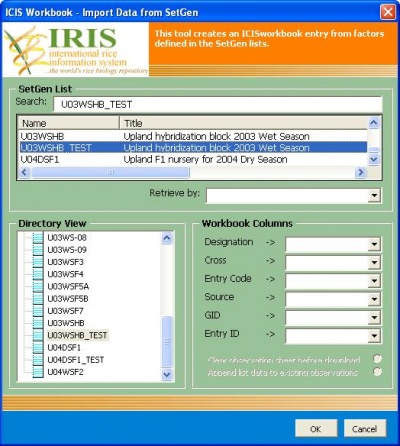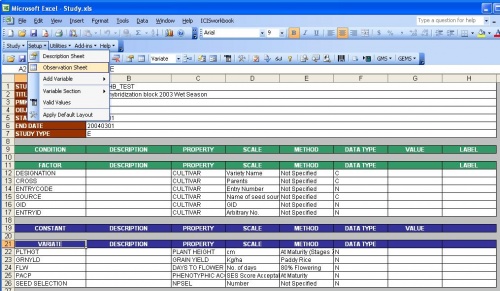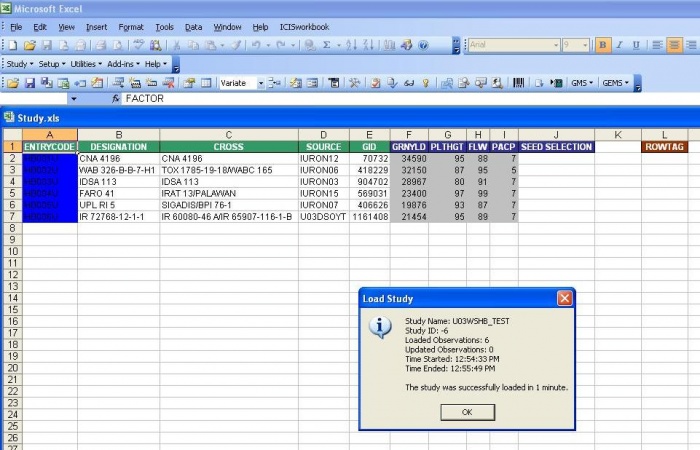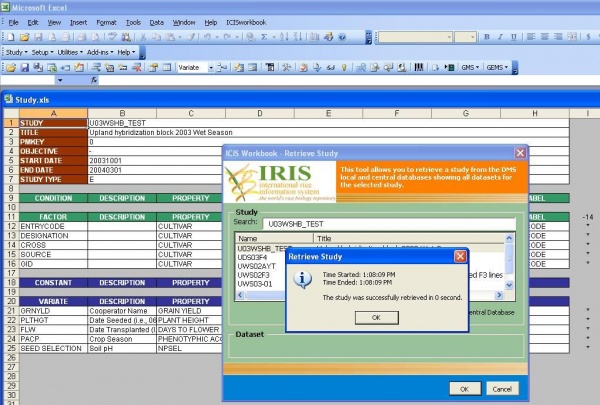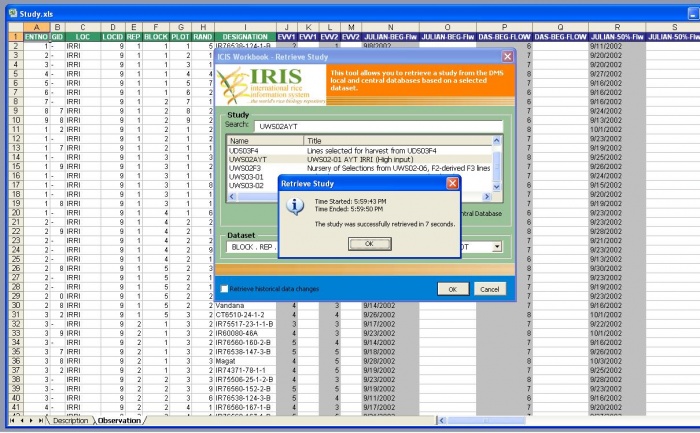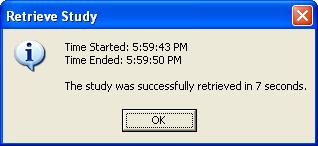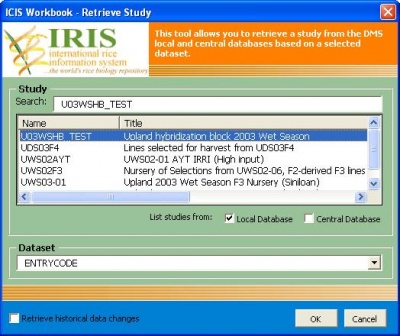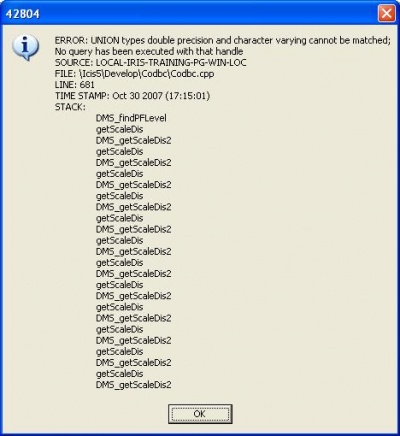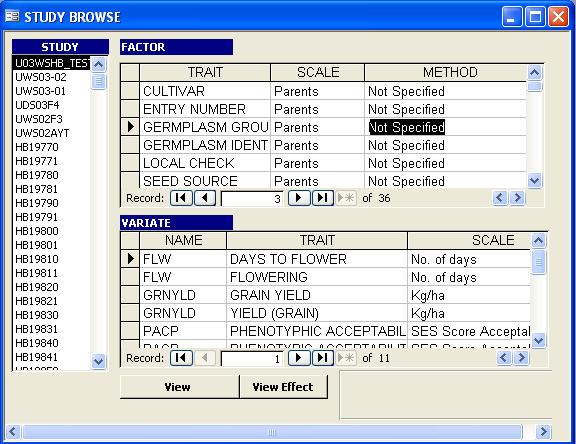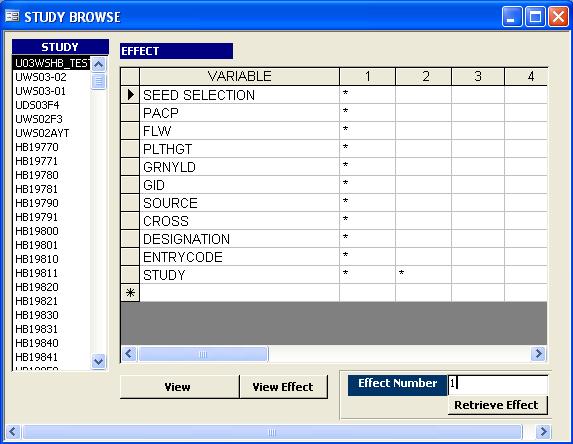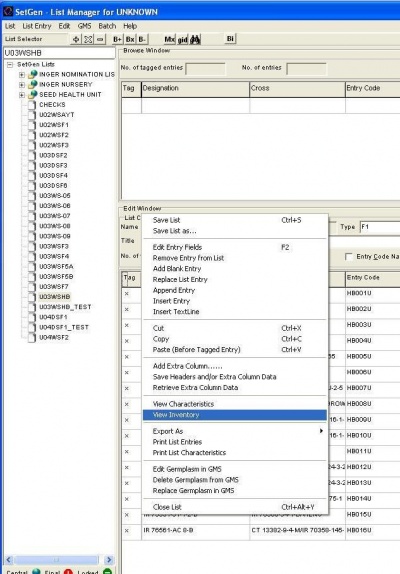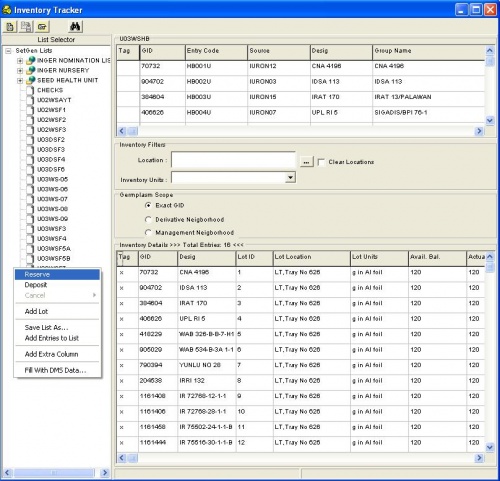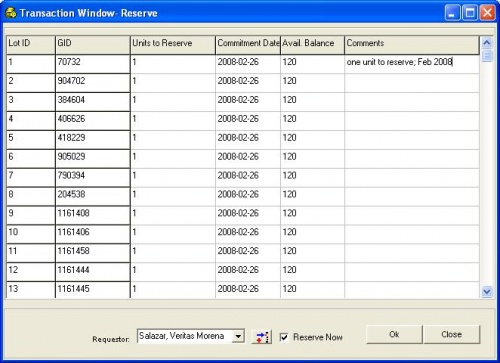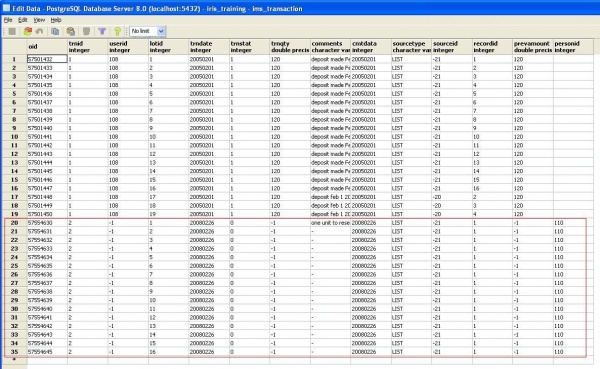Postgresql as Local GMS, Local DMS, and IMS
From ICISWiki
Database Backends > Postgresql as Local GMS, Local DMS, and IMS
Contents
|
Setup
Local GMS,Local DMS and IMS in Postgresql (v8.0; all three are in one database). Central DBs are in MS Access.
ICIS Schema version: 5.4 (Crop: Rice)
Testing procedure based on TDM Breeders' Training Course materials (v5.4)
ODBC Driver setup for "LOCAL-IRIS-TRAINING-PG-WIN-LOC" (local IRIS training PostgreSQL database on local machine):

Portion of the ICIS configuration file (.INI) used in the test:
Installation Diagnostic Tool
Application version: 5.4.2.8
Configuration Test
(Test ODBC connection)
Result: OK.
Database Test
Result: OK.
DLL Test (minimal)
Result: OK.
SetGen
Application version: 5.4.2.0
HB List
Create list
Result : OK.
Fill with...
Result : OK.
Naming Convention form pops up:
"Entry Code" column is renamed to "Sequence number"; column values are successfully filled up:
Save the list
Result: OK.
Export as XLS Excel File
Result: OK.
List --> Export as --> XLS Excel File:
Resulting Excel file:
F1 List
Create list
Listname: U04DSF1_TEST
Result: OK.
Generate crosses
- Click "+" button
- Use list U03WDHB_TEST
- Select Cross Name as name type; specify crossing location
- Use naming convention: "IR" as prefix, "90599" as start no.
Result: OK.
Fill with...
- Right click on "Entry code" column
- Select "Fill with Sequence"
- Set "P" as the Prefix, "1" as the Start No, leave the end constant blank; check (Include Leading Zeros) and set numeric field width to 3
Result: OK.
Save the list
Result: OK.
Export as XLS Excel File
Result: OK.
F2 Nursery
Create list
- Open the F1 list (select U04DSF1_TEST) in the Browse Window
- Select List>New>List from the List menu.
- Enter the list name: U04WSF2_TEST
- Enter the title: Upland F2 nursery for 2004 Wet Season (TEST)
- Select list type: F2
Result: OK.
Derive lines
- Tag all lines in F1 list
- Click Derive lines button ("-").
- Select "207 Random Bulk" as the method
- Select "Derivative Name" as the name type
- Source section: check "List name" and "Entry code" checkboxes
- Complete date and locations section.
- Click OK to all.
- An information window displays notifying the user that a germplasm with the same name was found.
- Select "Add another germplasm with this name" to add the same germplasm name but generate a different GID to the list.
- Click "Ok to All".
Result: OK.
Save the list
Result: OK.
Export as XLS Excel File
Result: OK.
Workbook
Application version: 5.4.2.0
Creating a Workbook file from a germplasm list
Add-ins --> Import SetGen List
- Select study U03WSHB_TEST
Result: OK
Setup Description Sheet
Provide basic info for study and setup the variables
- Specify start date
- Specify end date
- Specify study type: E (for experiment)
- Add 5 rows under "Variate" section: PLTHT, GRNYLD, FLW, PACP, SEEDSEL.
- Define the ontology for the newly-added variates: click Setup > Variable section > Express setup
- On the Variable Express setup form, select "Property first"
- "Use" menu:
- Click on PLTHT cell
- Click Use > Existing
- Click on SEEDSEL cell
- Click Use > Existing
- "Custom Setup" menu
- Click on "FACTOR" section
- Click Setup > Variable Section > Custom Setup
- "Define Variables" form pops up
- Select "FACTOR" on the dropdown list at the upper left corner of the form
- In the listbox immediately below, select "CROSS".
- Change the scale of CROSS from "SES Code Variety Group" to "Parents"
(Do the same for VARIATE section; make specific adjustments)
Result: OK
Setup Observation Sheet
- Adjust observation sheet based on description sheet contents
- Click Setup > Observation Sheet
- Observation sheet matches variables defined in description sheet
- Adjust description sheet based on observation sheet contents (if changes were made)
- Delete ENTRYID column
- Place the column GRNYLD before PLTHGT
- Click "Setup > Description Sheet"
- Specify the first variate through a dialog interface
- Fill in the data for the variates
Result: OK.
Load study data
- Click Study > Load
- Data Validation mode:
- In the training exercise, the LABELs are missing and PARENTS scale does not exist
- Erroneous cells are highlighted
- Fix the errors
- Try to load the study again (click Study > Load)
Result: Error message. Initially an error message window pops up,but the operation proceeds successfully after clicking "OK"
(This newly loaded study is assigned with STUDYID = -6. Study successfully loaded in 1 min.)
Check the underlying database if the study was indeed loaded... RESULT = OK.
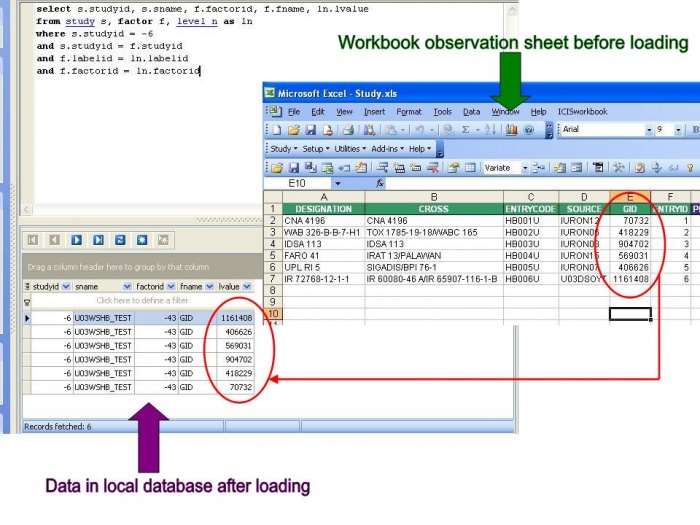
Retrieve factors & variates of study
- Click Study > Retrieve > Factors & Variates
- Select study U03WSHB_TEST (the study we loaded in the previous section; this study is in the local database)
Result: OK.
Retrieve study data
Case 1: Previously loaded study (MS Access as local at time of loading)
- IRIS local database [Training.MDB (with existing studies)] converted to PostgreSQL
- Click Study > Retrieve > Dataset
- Select study UWS02AYT
Result: Error message. Initially an error message window pops up (if during FIRST "Retrieve dataset" operation),but the operation proceeds after clicking "OK". Workbook says that "The study was successfully retrieved in 7 seconds".
Case 2: Newly loaded study (PostgreSQL as local at time of loading)
- Click Study > Retrieve > Dataset
- Select study U03WSHB_TEST (the study we loaded in the previous section; this study is in the local database)
Result: Error message. ("UNION types double precision and character varying cannot be matched") Initially an error message window pops up (if during FIRST "Retrieve dataset" operation),but the operation proceeds after clicking "OK". Workbook says that "The study was successfully retrieved in 41 seconds". HOWEVER...
...if we look at the data for the retrieved variates...
DMS Retriever
Training-RTV.mdb
Version: Unknown
- The form below is first screen that is seen. Click "Study Browse":
- Select the study we loaded:
- Click "View Effect". Then
Result: OK. Retrieval successful!

InTrack
Application version: 5.4.2.1
Reserving of seed stock for HB List
View inventory information
- Start Setgen from Launcher, double-click on U03WSHB from the List Selector.
- Tag all items in the edit window to view inventory.
- Right-click on the white space and select <View Inventory> on the pop-up menu.
Result: OK.
Reserving seeds
Mark seeds to reserve
- Tag all the items in the inventory details section of the Inventory Tracker window
- Right-click on the white space and select <Reserve> on the pop-up menu. The Transaction window will display on the screen.
Result: OK.
Transaction window - Reserve
- Encode on the space provided for each item the number of units to reserve, fill in commitment date of the reservation and any comment on the reservation being made.
Result: OK.
Changes are reflected in the underlying PostgreSQL database:
Depositing of Seed Stock for F5 List
Create lot location for the F5 list
Select list
- Double-click list U03WSF5A
- Right-click on the inventory details section of the Inventory Tracker window
- Select <Add Lot> from the pop-up menu
Result: OK. Message window pops up: "Please fill up List/GID/lot location/lot units"
Specify lot location
- Click button with elipses "..."
- Select <Short Term> on the Collection drop-down list
- Select <ST, Tray No. 998> on the Tray drop-down list
- Click on the <OK> button to close the window and update the location field on the inventory details section.
Result: OK.
Specify inventory units, comments
- Select <Packet> on the Inventory Units drop-down list.
- On the Comments field, type “lot created for Postgres test”
Result: OK.
Save lot information
- Click on the <Save> button on the toolbar to update the database.
Result: OK
Deposit seed stock for the F5 list
- Tag all the items in the Inventory Details section.
- Right-click on the white space and select <Deposit> on the pop-up menu.
- The Transaction window (Deposit) displays on the screen.
- Encode the number of units to deposit, commitment date of the deposit and any comment on the deposit being made.
- Click on <Ok> to save changes.
Result: OK.
Summary of Testing
| ICIS Application | Process/function | Result | Remarks | |
|---|---|---|---|---|
| Installation Diagnostic Tool v5.4.2.8 | Check ODBC Connection (Configuration Test) | OK | ||
| Check database structure (Database Test) | OK | |||
| Check some DLL functions (DLL Test (minimal)) | OK | |||
| SetGen v5.4.2.0 | HB List | Create list | OK | |
| Fill with... | OK | |||
| Save list | OK | |||
| Export as XLS Excel file | OK | |||
| F1 List | Create list | OK | ||
| Generate crosses | OK | |||
| Fill with... | OK | |||
| Save list | OK | |||
| Export as XLS Excel file | OK | |||
| F2 Nursery | Create list | OK | ||
| Derive lines (advance a line one generation) | OK | |||
| Save list | OK | |||
| Export as XLS Excel file | OK | |||
| Workbook v5.4.2.0 | Create a Workbook file from a germplasm list | Add-ins --> Import SetGen list | OK | |
| Setup Description Sheet | OK | |||
| Setup Observation Sheet | OK | |||
| Load study data | Error message | Initially, an error message window pops up,but the operation proceeds successfully after clicking "OK" | ||
| Retrieve factors & variates of study | OK | |||
| Retrieve study data | Case 1: Previously loaded study (MS Access as local at time of loading) | Error message | Initially, an error message window pops up: "UNION types double precision and character varying cannot be matched". Note: An error message only appears when during the FIRST retrieval of a study dataset. If a study is already open, and you retrieve another study dataset, the error message does not pop up anymore. | |
| Case 2: Newly loaded study (PostgreSQL as local at time of loading) | Error message |
| ||
| InTrack v5.4.2.1 | Reserving of seed stock for HB List | View inventory (launch from SetGen) | OK | |
| Reserve seeds | OK | |||
| Depositing of Seed Stock for F5 List | Create lot location for F5 list | OK | ||
| Deposit seed stock | OK | |||
| DMS Retriever | Training-RTV.mdb (version uknown) | Browse study | OK | Further investigation & testing required |
